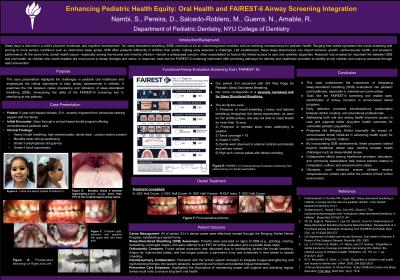Other
228 - Enhancing Pediatric Health Equity: Oral Health and FAIREST-6 Airway Screening Integration

.jpg)
Daniela Pereira
Dental Student D4
New York University
New York University
New York City, New York, United States- JG
Jeyri Galvanez, Dental Student
NYU College of Dentistry
- NG
Nestor Guerra, Undergraduate Student
NYU College of Dentistry
- SN
Saravanan Nambi, DDS
NYU College of Dentistry
- RA
Rose J. Amable, DDS
Adjunct Clinical Assistant Professor
New York University, New York, NY
New york City, New York, United States - LF
Lauren M. Feldman, DMD, MPH
Pediatric Dentistry Program Director
New York University
New York City, New York, United States
Presenting Author(s)
Co-Author(s)
Research Mentor(s)
Program Director(s)
This case presentation highlights the challenges in pediatric oral healthcare and emphasizes the critical importance of early airway assessments in children. It examines the link between caries prevalence and indicators of sleep-disordered breathing (SDB), showcasing the utility of the FAIREST-6 screening tool in identifying at-risk patients.
Case Presentation: This report discusses a 5-year-old Hispanic female, S.H., who recently migrated to the USA from Venezuela with her family seeking asylum. S.H. was first seen at our school-based dental program providing comprehensive pediatric dental care. During her clinical examination, multiple findings pointed to significant oral health and airway concerns. These included heavy mouth breathing, mentalis strain during swallowing, a high-arched palate, Grade 3 tongue tie, severe dental wear, and Grade 4 tonsil hypertrophy. Radiographic analysis revealed cavitated lesions in primary molars and canines. Applying the FAIREST-6 screening tool identified six red flags for SDB, confirming a severely increased risk. The patient's symptoms were consistent with a functional airway issue that likely contributed to her dental and behavioral challenges.
Conclusion: This case underscores the necessity of integrating SDB evaluations into pediatric oral healthcare, particularly in underserved communities. The utilization of tools like FAIREST-6 within school-based programs facilitates early detection of airway issues and promotes interdisciplinary collaboration. By addressing both oral and airway health in vulnerable pediatric populations, such initiatives improve access to care and foster better long-term health outcomes.
Identify Supporting Agency and Grant Number:

.jpg)